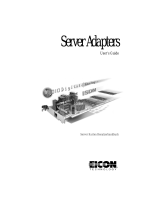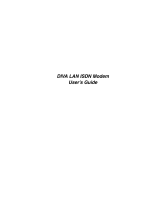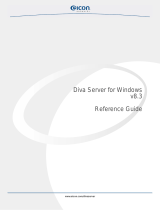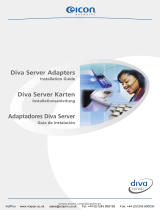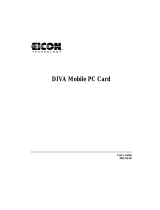Page is loading ...

www.eicon.com
Diva 2440 ADSL Router
User’s Guide

Page 2
Second Edition (June 2001) 206-378-02
Diva and Eicon are either registered trademarks or trademarks of Eicon Networks Corporation.
Microsoft, Windows, and Windows NT are either registered trademarks or trademarks of Microsoft
Corporation in the United States and/or other countries.
Adobe and Acrobat are either registered trademarks or trademarks of Adobe Systems Incorporated in
the United States and/or other countries.
Apple and Macintosh are trademarks of Apple Computer, Inc. in the United States and/or other
countries.
IBM is a registered trademark of IBM Corporation in the United States and/or other countries.
All other brand and product names are trademarks or registered trademarks of their respective owners.
Changes are periodically made to the information herein; these changes will be incorporated into new
editions of the publication. Eicon Networks may make improvements and/or changes in the products
and/or programs described in this publication at any time.
If you have comments on this manual or the products it describes, address them to:
Eicon Networks Corporation
Attention: Technical Publications
9800 Cavendish Blvd.
Montreal, Quebec
Canada H4M 2V9
Eicon Networks Corporation may use or distribute whatever information you supply in any way it
believes appropriate without incurring any obligations to you.
Eicon Networks Corporation is a business unit of i-data international a-s.
Copyright © 1999-2001 Eicon Networks Corporation. All rights reserved, including those to reproduce
this publication or parts thereof in any form without permission in writing from Eicon Networks
Corporation.

Page 3
Contents
Introduction.....................................................................................................5
Introducing the Diva 2440 ADSL Router.................................................................................. 6
Package Contents.................................................................................................................... 7
Connection Scenarios.............................................................................................................. 8
How ADSL Works .................................................................................................................. 10
Setup..............................................................................................................11
Overview ................................................................................................................................ 12
Internet Account Information.................................................................................................. 13
Ports and Indicator Lights ...................................................................................................... 14
Step 1: Connect the Cables ................................................................................................... 16
Step 2: Access the Diva 2440 Web Interface......................................................................... 18
Step 3: Complete the Internet Wizard.................................................................................... 19
Optional: Installing the Diva Assistant.................................................................................... 21
Connecting a Second Computer............................................................................................ 23
LAN Setup ............................................................................................................................. 24
TCP/IP Setup......................................................................................................................... 27
Troubleshooting...................................................................................................................... 31
Connecting a Phone to the Pass-through Phone Port ........................................................... 32
About Microfilters ................................................................................................................... 33
Technical Support .................................................................................................................. 34
Using your Diva 2440 ...................................................................................35
General Information ............................................................................................................... 36
Resetting the Device.............................................................................................................. 37
Starting the Web-based Configuration Interface.................................................................... 38
Configurations – Saving, Restoring, and Resetting ............................................................... 40
Upgrading Firmware .............................................................................................................. 41
Login Password and other Security Features ........................................................................ 43
About the Diva Assistant........................................................................................................ 45
Advanced Topics..........................................................................................47
Virtual Private Networking ..................................................................................................... 48
Network Address Translation ................................................................................................. 52
Command Line Interface (CLI)............................................................................................... 56
Using TFTP to Transfer Files ................................................................................................. 58
Command Line Reference ...........................................................................60
Overview ................................................................................................................................ 61
ADSL Commands .................................................................................................................. 62
ATM Commands .................................................................................................................... 63
DHCP Commands ................................................................................................................. 64
Ethernet Commands.............................................................................................................. 67

Page 4
Filter Commands .................................................................................................................... 68
General Commands ............................................................................................................... 72
IP Commands (General)......................................................................................................... 74
IP Routing Commands ........................................................................................................... 76
Logging and Internal Trace Commands ................................................................................. 77
NAT (Network Address Translation) Commands .................................................................... 78
PPP Commands..................................................................................................................... 79
Profile Commands .................................................................................................................. 82
SAR Commands..................................................................................................................... 83
TFTP Commands ................................................................................................................... 84
Time Protocol Commands...................................................................................................... 85
Specifications and Regulatory Information ...............................................86
Specifications ......................................................................................................................... 87
Regulatory Information for the United States ......................................................................... 89
Regulatory Information for Canada ........................................................................................ 91
Regulatory Information for the European Union..................................................................... 92
Index ..............................................................................................................93

Introduction Page 5
Introduction
This chapter provides introductory information on your Diva 2440 ADSL Router.
Introducing the Diva 2440 ADSL Router ......................................................6
Package Contents ..........................................................................................7
Connection Scenarios ...................................................................................8
How ADSL Works.........................................................................................10

Introduction Page 6
Introducing the Diva 2440 ADSL Router
The Eicon® Networks Diva 2440 ADSL Router provides fast access to the Internet via ADSL
and is perfect for home users and small office / home office users. It is easy to set up and has
many features that will help you get the most out of your ADSL line.
The Diva 2440 can accommodate two users directly via its Ethernet and USB ports (USB can
be used with Windows® 98/2000/Me only). You can also connect a hub to the Diva 2440 and
share Internet access amongst all users on the network. The Diva 2440’s built-in DHCP server
can automatically assign IP addresses to all workstations on your LAN.
The Diva 2440 addresses security concerns via built-in Network Address Translation (NAT)
which allows multiple computers to share a single external IP address while making them
invisible to the Internet.
The Diva 2440 also features a pass-through telephone port with built-in microfilter.
The following provides a brief overview of the many features of the Diva 2440.
General Features
• Easy to Set Up: Installation is a simple and straightforward procedure. You will be up and
running in just a few minutes.
• Web-base Configuration: The Diva 2440 is configured via a web browser. Settings are
organized in logical groups, and making changes is quick and easy.
• Command Line Interface: All settings can also be configured using a command line interface
(Telnet application required).
ADSL and Network Features
• Support for Full-rate and G.Lite ADSL: The Diva 2440 is an ADSL (Asymmetric Digital
Subscriber Line) device supporting transfer of up to 8 Mbps. Two popular versions of ADSL
are built in to the Diva 2440, Full-rate and G.Lite.
• DHCP Support: The Diva 2440 can act as a DHCP server for your LAN. This lets you avoid
having to assign specific IP addresses to the computers on your network.
Hardware Features
• USB and Ethernet Ports: The Diva 2440 can connect to your computer through both the
Ethernet and USB ports (USB is Windows 98/2000/Me only). Setup via either port is simple
and easy. You can also connect the Diva 2440 to an Ethernet hub, giving all computers on
the network access to the Internet.
• Simultaneous Port Usage: The USB and Ethernet ports can be used simultaneously. You
can connect one computer to the Ethernet port and another to the USB port, and both devices
can access the ADSL line when needed or exchange data between the two local computers.
See Connection Scenarios on page 8 for more information.
• Upgradable Firmware: The Diva 2440’s firmware (a set of software instructions that tells the
device how to operate) is stored in flash memory on the device. This makes it easy to upgrade
the firmware should it become necessary to do so.

Introduction Page 7
Package Contents
Your package should contain the following.
The yellow Ethernet cable is a crossover cable and is used to connect the Diva 2440 directly to
a single computer. To connect the Diva 2440 to a network hub, you must use the included
straight-through Ethernet cable. (This cable may be blue or grey.) You can also connect the
yellow cable to the hub’s uplink port, if available.
In addition, your package may include the following:
• A phone adapter may be provided for the ADSL cable if your wall jack is not RJ11 compatible.
• A microfilter may be provided if an ADSL splitter is not being used on your premises. The
microfilter is connected between regular telephone devices and wall jacks in order to reduce
background noise. If you are unsure if you should use a microfilter, contact your ADSL provider.
Diva 2440 Quick Install Guide
Ethernet Crossover
Cable (Yellow)
Ethernet Straight-through
Cable (Blue or Grey)
ADSL
Phone Cable
USB Cable Power Supply CD-ROM

Introduction Page 8
Connection Scenarios
The Diva 2440 has both a USB port and an Ethernet port. Both ports can be used at the same
time, providing some flexibility in how you set up your equipment. You can also connect the
Ethernet port to a third-party Ethernet hub.
One Computer
For all operating systems that support an Ethernet network card, you may connect to the
Diva 2440 via the Ethernet port. If you are using Windows 98, Windows 2000, or Windows
Millennium Edition, you can connect a single computer to either the USB port or the Ethernet
port.
Two Computers at Once
You can connect two computers to the Diva 2440 for simultaneous access to your ADSL line.
One computer is connected to the USB port and the other to the Ethernet port. The computer
connected to the USB port must be using Windows 98/2000/Me.
Ethernet cable (crossover) or
USB (Windows 98/2000/Me only)
ADSL line
Diva 2440
Ethernet cable
(crossover)
ADSL line
USB
Diva 2440

Introduction Page 9
More than Two Computers
A third-party hub can be connected to the Ethernet port, giving all computers on the network
access to the ADSL line. Furthermore, you are still free to connect a computer to the USB port
as long as the computer is using Windows 98/2000/Me.
If you plan on connecting the Diva 2440 to a hub or an existing local-area network as described
above, see LAN Setup on page 24.
Ethernet cables
ADSL line
Third-party hub
Diva 2440
Ethernet cable
(straight-through)

Introduction Page 10
How ADSL Works
ADSL uses regular household telephone lines to receive and transmit data. To accomplish this
task, ADSL data is transmitted on frequencies outside of the normal voice call range. This way
the signals from the two devices do not interfere with each other.
ADSL provides two major benefits:
• Phone lines always free: Although the Diva 2440 uses the same wiring as your regular
telephone, you can still pick up the phone and make a call at any time.
• Instant access: Unlike traditional dial-up modems, a connection made using the Diva 2440
is always on. You no longer have to wait while your modem dials into your Internet provider.
Splitters and ‘Splitterless’ Operation
A splitter is a device installed at the entry point of the telephone line to your house and is used
to eliminate interference between the ADSL and voice signals. However, splitters must be
installed by a technician from your telephone company and usually require new telephone
wiring to be installed.
The Diva 2440 can operate with or without a splitter with both Full-rate and G.Lite ADSL.
Microfilters
For most splitterless installations, you most likely will need to install a microfilter between your
telephone devices (telephone, fax machine, answering machine) and the telephone jacks.
Microfilters filter out the frequencies outside of the normal voice call range and reduce
interference between ADSL transmissions and voice transmissions.
See About Microfilters on page 33 for more information. Microfilters may or may not be
included in your package. Contact your ADSL provider for more details.

Setup Page 11
Setup
This section describes how to set up your Diva 2440 to a single computer. General instructions
for a LAN installation are also included.
Overview .......................................................................................................12
Internet Account Information......................................................................13
Ports and Indicator Lights...........................................................................14
Step 1: Connect the Cables ........................................................................16
Step 2: Access the Diva 2440 Web Interface .............................................18
Step 3: Complete the Internet Wizard ........................................................19
Optional: Installing the Diva Assistant ......................................................21
Connecting a Second Computer ................................................................23
LAN Setup.....................................................................................................24
TCP/IP Setup ................................................................................................27
Troubleshooting ...........................................................................................31
Connecting a Phone to the Pass-through Phone Port .............................32
About Microfilters ........................................................................................33
Technical Support........................................................................................34

Setup Page 12
Overview
Before you begin, please read the following general installation information.
Connecting to Both Ports
Once you connect a computer to either the USB or Ethernet port, you can connect a second
computer to the unused port without reconfiguring the Diva 2440. However, to help ensure a
problem-free setup, connect only one computer and verify that the device is working correctly
before connecting a second computer.
Requirements
Your system requirements will depend on the type of installation and the computer you are
using.
Ethernet The Diva 2440 will work with any computer equipped with the
following:
• A 10BASE-T Ethernet network interface card, properly installed and
configured to use the TCP/IP protocol. Consult the documentation
that came with your card for instructions on how to do this. A
100 Mbps Ethernet card can be used if the card supports
auto-sensing.
• TCP/IP communications protocol configured to obtain its IP address
automatically (DHCP client), and not configured to use a DNS server.
See TCP/IP Setup on page 27 for more information.
USB To connect using the Diva 2440’s USB port, you will require a
computer running Windows 98, Windows 98 SE, Windows 2000, or
Windows Millennium Edition, equipped with an freeUSB port. You
cannot use the Diva 2440’s USB port with Windows 95, Windows NT,
Apple® Macintosh®, or other systems.
Web Browser The Diva 2440 is configured via web pages stored on the device. To
use the web interface, you must be using Netscape Navigator 3.01 or
Microsoft® Internet Explorer 4, or later versions. Additionally, your
Web browser must be configured to connect to the Internet via a local
area network (LAN) and not through a proxy server.
An installer for Microsoft Internet Explorer is included on the Diva
CD-ROM for all Windows operating systems except Windows 3.1.
Windows NT® 4.0 requires SP3 or later, available from
www.microsoft.com.
Diva Assistant The Diva 2440 includes the Diva Assistant software, compatible with
all Windows operating systems except Windows 3.1. The Diva
Assistant provides convenient utilities and is also very useful during a
LAN setup, but it is not required in order to use the Diva 2440.

Setup Page 13
Internet Account Information
During setup, you must enter account information as specified by your provider. Write this
information down for future reference.
• VPI setting
• VCI setting
• Encapsulation
• Connection Type
• Username and password, if your connection type is set to ‘PPP over Ethernet’ or ‘PPP over
AT M’.
• IP and DNS addresses, if your connection type is set to ‘IP over ATM’.
Note: Most or all settings should be supplied by your ADSL provider.

Setup Page 14
Ports and Indicator Lights
Before you begin installation, take a moment to become more familiar with the ports and
indicator lights of the Diva 2440.
Ports
Phone Port
This port is used for connecting a telephone
or other analog device, and is available with
certain models only.
ADSL Port
This port is used for connecting
the ADSL cable to your
telephone jack.
Reset Button
The reset button is located on the
side or on the bottom, depending
on the model. Press this button
once to reset the device. Warning:
Pressing the Reset button for 15
seconds resets the device back to
factory defaults.
Power Connector
Used for connecting the
Diva 2440 to an electrical outlet.
Ethernet Port
Used for connecting the Diva 2440 to a
computer’s Ethernet adapter or to a
network hub.
USB Port
Used for connecting the Diva 2440 to a computer
equipped with a USB port. Can only be used with
computers running Windows 98, Windows 2000, or
Windows Millennium Edition. It cannot be used with
Windows 95, Windows NT, Macintosh, or other systems.
Both the Ethernet and USB ports can be used at the
same time, providing Internet access for two
computers without a hub. You can also connect the
Ethernet port to a hub and use the USB port with
another computer.

Setup Page 15
Indicator Lights
Power Light
Solid Green: The unit is on and working correctly.
Off: The power adapter is not connected.
Red: The device has encountered a fault condition or is
in boot mode. Press the Reset button once to return the
device to normal.
Ethernet Light
Solid Green: The Ethernet cable
is connected properly.
Flashing: Data is being transferred
to or from your computer over the
Ethernet cable.
Off: The Ethernet cable is
not connected.
USB Light
Green: The USB cable is properly
connected and the operating system is
configured to use the device.
Flashing: Data is being transferred to or
from your computer over the USB cable.
Off: The cable is not connected properly
or the operating system is not configured
for this device. This light may also go off if
your computer is put in low power mode.
Receive and Transmit Lights
Flashing: Data is being received or
transmitted via the ADSL connection.
Off: Data is not being received or transmitted.
ADSL Light
Solid Green: An ADSL connection has
been established.
Flashing Green: The Diva 2440 is
attempting to synchronize with your
provider’s ADSL network.
Off: The ADSL cable is not connected
properly, or your ADSL service provider
has not yet activated ADSL services on
your line.

Setup Page 16
Step 1: Connect the Cables
Leave your computer on when connecting the cables.
As shown in the diagram below, both the USB and Ethernet ports can be used at the same
time. However, it is recommended that you use only one port during setup. Once you have
verified that you can access the Internet, you can then connect a second computer.
ADSL Cable Notes
• Do not install a microfilter on the cable that connects your ADSL device to the telephone jack.
• If your Diva 2440 has a phone port, make sure you do not use this port to connect the ADSL
cable.
• Several seconds after connecting the ADSL cable, the ADSL indicator light ( on the front
of the device) should start flashing. This light will stop flashing and stay on when a link has
been established with your ADSL service provider’s network.
Ethernet Cable Notes
• The Ethernet port can be used with any computer supporting an Ethernet card and TCP/IP.
• When connected, the Ethernet indicator light ( on the front of the device) will turn green
when the Diva 2440 is plugged in and the computer is on.
• When finished connecting the cables, restart your computer so that your Ethernet card
acquires a new IP address.
Yellow
Ethernet
Cable
ADSL
Cable
Power
Adapter
USB
Cable
To
Phone
Jack

Setup Page 17
USB Cable Notes
• USB requires Windows 98, Windows 2000, or Windows Millennium Edition. USB will not work
with Windows 95 or Apple Macintosh computers.
• Once the power and USB cables are connected, Windows will request driver files. Follow the
onscreen instructions, as described below.
Updating or reinstalling USB drivers
If you must reinstall or update the USB drivers, follow the instructions below.
7.
From your desktop, right-click ‘My Computer’, click ‘Properties’, then click the ‘Device
Manager’ tab. The System Properties window opens.
8.
Double-click ‘Network Adapters’, right-click ‘Eicon Diva 2400 Series Virtual LAN Adapter for
USB’, and select ‘Properties’. The dialog box opens.
9.
Click the ‘Drivers’ tab and click ‘Update Driver’. Follow the onscreen instructions. You will
asked to insert your Windows Installation Disk, and you will also need the new USB drivers.
The drivers are also located in the USB folder on the Diva CD-ROM.
Note: This procedure may vary according to the Operating System installed.
To continue
See Step 2: Access the Diva 2440 Web Interface on page 18.
Windows 98
1.
Insert the Diva CD-ROM into your CD-ROM drive.
2.
From the ‘Hardware Wizard’ window, click ‘Next’.
3.
Select the option ‘Search for the best driver’, then click ‘Next’.
4.
When asked for the location of the driver files, select ‘Specify a
location’ and clear all other options. In the ‘Location’ field, type in
D:\USB\WIN98 (with ‘D’ being the letter of your CD-ROM drive), then
click ‘Next’.
5.
Once the driver is located, click ‘Next’ to begin installation.
6.
When installation is complete, click ‘Finish’.
Windows Me
1.
Insert the Diva CD-ROM into your CD-ROM drive.
2.
Select ‘Specify the location of the driver’, then click ‘Next’.
3.
For the location, type in D:\USB\WIN98 (with ‘D’ being the letter of
your CD-ROM drive), then click ‘Next’.
4.
When installation is complete, click ‘Finish’.
Windows 2000
1.
Insert the Diva CD-ROM into your CD-ROM drive.
2.
Click ‘Next’.
3.
Select ‘Search for a suitable driver’, then click ‘Next’.
4.
When asked for the location of the driver files, select ‘Specify a
location’ and clear all other options. In the ‘Location’ field, type in
D:\USB\WIN98 (with ‘D’ being the letter of your CD-ROM drive), then
click ‘Next’.
5.
Once the driver is located, click ‘Next’ to begin installation.
6.
When installation is complete, click ‘Finish’.

Setup Page 18
Step 2: Access the Diva 2440 Web Interface
To access the Internet through your provider’s network, you must first enter configuration
information, such as username and password, via a web browser (Internet Explorer 4.0 or
later, or Netscape Navigator 3.0 or later). If you do not have a web browser, an installer for
Internet Explorer for Windows is located in the ‘bonus’ folder on the Diva CD-ROM.
1.
Make sure you have restarted your computer. (If you are using the USB port, Windows should
have already asked you to do so upon installation of the USB drivers.)
2.
Launch your web browser.
3.
Click ‘File’, ‘Open’, enter 192.168.1.1 and click ‘OK’.
4.
The Diva 2440 main configuration page should appear.
Note: If you do not see the main configuration page, see Troubleshooting on page 31.
5.
To continue, see Step 3: Complete the Internet Wizard on page 19.

Setup Page 19
Step 3: Complete the Internet Wizard
All parameters should be specified by your ADSL provider. See Internet Account Information
on page 13 for more information.
1.
From the main menu, click ‘Internet Wizard’.
2.
This first page of the Internet Wizard displays the detected VPI/VCI settings for your
ADSL connection.
If the default settings are incorrect, click the ‘Internet Wizard - Step 1 (Advanced)’ link to edit
the settings. Otherwise, click the ‘Next’ button to continue.
3.
In Step 2 of the wizard, you are presented with ‘encapsulation’ and ‘connection type’ settings.
Normally, these settings are detected automatically, and you should only have one option
for each.
Click the ‘Next’ button to continue.
‘Internet
Wizard’
link

Setup Page 20
4.
Step 3 in the wizard will differ depending on the connection type specified in Step 2.
• If you are using a connection-oriented type (‘PPP over Ethernet’ or ‘PPP over
ATM’), you will be asked to enter your username and password.
• If you are using an always-on connection type (‘IP over ATM’), you will be asked
for your IP and DNS addresses.
Click the ‘Finish’ button to complete the setup wizard.
If an error is reported, see Troubleshooting on page 31.
Setup Complete!
Congratulations! You may now surf the Internet!
Try accessing an external web page, such as www.eicon.com (Eicon Networks’s web site).
It is recommend you register your purchase right away. Visit the Diva 2440 web page at
www.eicon.com/diva2440.
/

